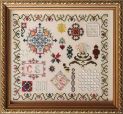|
Man, it seems, has an insatiable appetite to liven up his surroundings. From the earliest known fabric examples dating from 3000 B.C. to modern day three-dimensional thread creations, humans seem wont to enliven our clothing, toiletries and linens by adding hand work of some kind over the woven threads. Current Western culture links needle and thread to women. Originally, however, they relegated the task to men - in both Western and Eastern cultures, who served up to an eight-year apprenticeship before being considered a master at his craft.
Many earlier stitches are now our most common and more easily executed ones. The golden age of Western embroidery coincides with the golden age of music: the baroque period during the 17th and 18th centuries. For embroidery, it lasted into the mid-1800's. At that time, the invention of embroidery machines devastated the hand embroidery industry, causing major economic crises in many parts of the world.
Whether it is adorning bed linens, table linens, vestments, furniture or clothing, people are still embroidering all over the world. Machines can emulate the fine handwork, but none can duplicate it. A wealth of media is available to the modern embroiderer, but little of it unique as can be observed by the above examples.
(The above was taken from History of Embroidery Essay at the Heritage Shoppe site)
On this site you will see examples of several types of counted needlework. These types include: Assisi,
Blackwork, Cross Stitch, and Drawn Thread work of all kinds.
|
